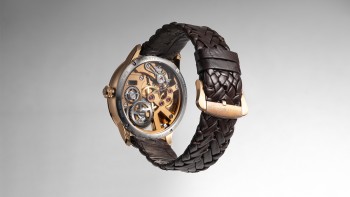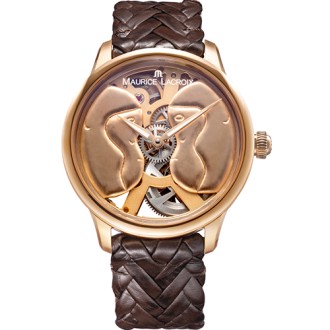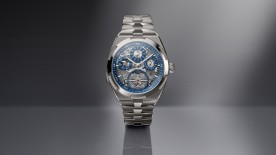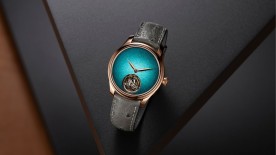ART X MAURICE LACROIX
In recent years, Maurice Lacroix has worked with several artists and design experts. For instance, the watch brand has previously collaborated with Wallpaper Magazine, reinventing the PONTOS with various designers, including Jean Nouvel, Kris Van Assche, and Patricia Urquiola. Moreover, in 2022, the luxury marque invited the Thai street-artist, Benzilla, to create a new expression of the AIKON #tide. For the second edition of TimeForArt, the Swiss Maison has chosen to work with Rodrigo Hernández, the multi-award winning artist.
MAURICE LACROIX AND RODRIGO HERNÁNDEZ
TimeForArt introduced Rodrigo Hernández to the Maison, recognizing that both parties share much in common. While proud of its Swiss roots, Maurice Lacroix continuously showcases its urban-style watches to a global audience, a characteristic it shares with Rodrigo Hernández, an artist who has exhibited his work around the world. When reinterpreting the MASTERPIECE Skeleton, Hernández was given full creative freedom to express his own ideas and craft a horological sculpture in materials of his choosing.
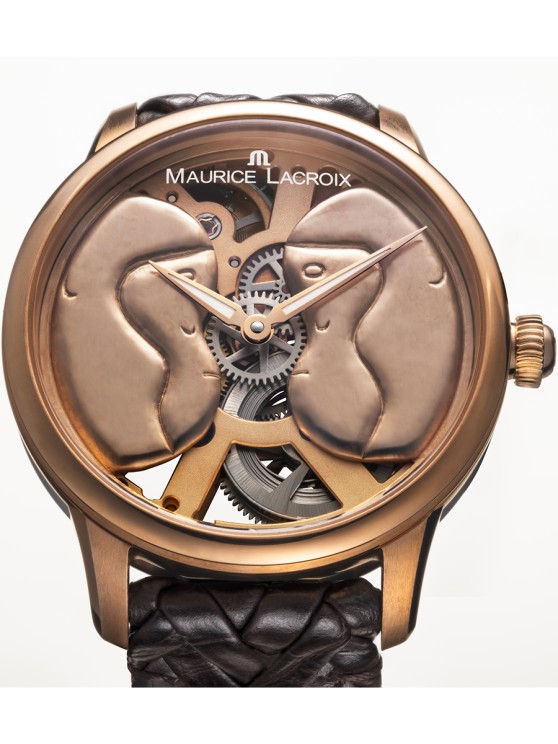
Adroit at working in various mediums, Hernández is widely known for his brass and bronze reliefs. By contemplating time from a different perspective and finding inspiration from the animal world, Hernández, working in collaboration with Maurice Lacroix, has created a highly imaginative wrist-worn sculpture, presented in a 43 mm case.
MAURICE LACROIX MASTERPIECE SKELETON ‘WITH WHAT EYES?’
Mexican philosopher David M. Peña-Guzmán posed a question, “Are humans the only dreamers on Earth?” This question resonated with Hernández leading him to create a new body of work exhibited at the Wattis Institute in San Francisco. The Maurice Lacroix MASTERPIECE Skeleton ‘With what eyes?’ delves into this philosophical meditation with the captivating representation of two monkeys staring at each other, executed in handcrafted bronze. This alloy of copper and tin has been used in the making of important statues for thousands of years and is often viewed with due reverence, making it an ideal medium for this wrist-worn sculpture. Hernández remarks. “I like the use of materials whose firmness and solidity can act in contrast with the ideas they try to represent”. By using bronze, the Mexican artist has created a piece of ticking art, destined to be admired for years to come.
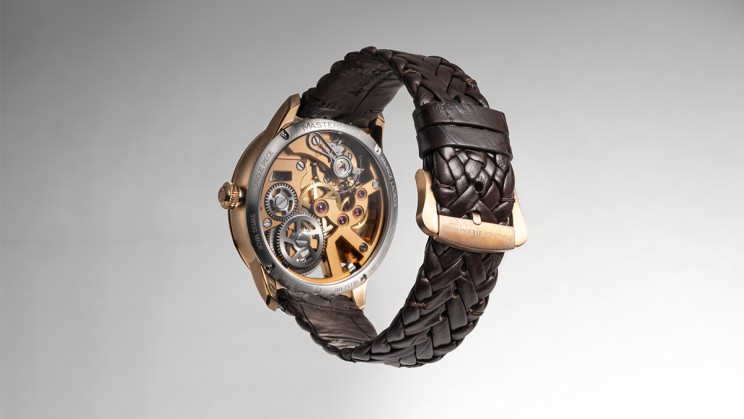
Mexican philosopher David M. Peña-Guzmán posed a question, “Are humans the only dreamers on Earth?” This question resonated with Hernández leading him to create a new body of work exhibited at the Wattis Institute in San Francisco. The Maurice Lacroix MASTERPIECE Skeleton ‘With what eyes?’ delves into this philosophical meditation with the captivating representation of two monkeys staring at each other, executed in handcrafted bronze. This alloy of copper and tin has been used in the making of important statues for thousands of years and is often viewed with due reverence, making it an ideal medium for this wrist-worn sculpture. Hernández remarks. “I like the use of materials whose firmness and solidity can act in contrast with the ideas they try to represent”. By using bronze, the Mexican artist has created a piece of ticking art, destined to be admired for years to come.
Hernández created a mould depicting the heads of the monkeys. This was subsequently used to create the dial and formed in bronze. Maurice Lacroix, keen to perpetuate the tradition of métier d’art, hand engraved the dial and positioned it to the front of the watch. The dial, portraying two monkey heads, resembles the work recently exhibited at the Wattis Institute, albeit depicted in a smaller format. The artist explains, “It’s known that monkeys are very close to us from an evolutionary point of view, but this closeness does not make their world less unique. They have conscious experiences that are inherently subjective and hard to fully comprehend. In thinking about other animals, we are biased by our senses and by our vision in particular. So, by putting two monkeys facing each other I want to think about the moment when two equals can really see each other for what they are without this aforementioned bias.”
Beneath the hour and minute hands, the hour wheel is freely disclosed, sitting at the centre of two worlds, namely that of the watch brand and the sculptor.
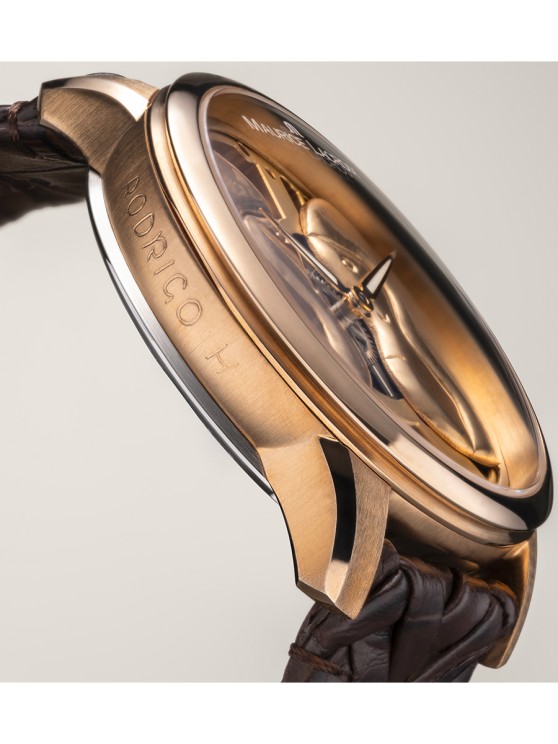
The bronze case juxtaposes polished and brushed surfaces and confers a warm, golden appearance. Like many works of art, it’s signed by the artist, on this occasion at 9 o’clock. To the rear of the watch, a stainless steel caseback incorporating a pane of sapphire crystal affords sight of the MASTERPIECE ML134 Manufacture Calibre. This hand-wound movement features a three-quarter plate, granting torsional rigidity to the skeletonised structure. The plate and bridges are executed in a golden sandblasted finish, serving as a foil to Hernández’s gleaming sculpture located centre stage.
A hand-braided leather strap, accompanied with a bronze buckle, was selected by the artist to complement the handcrafted dial.
Stéphane Waser, Managing Director of Maurice Lacroix, remarks, “We are delighted to support TimeForArt again. This initiative brings together two complementary worlds, namely art and watchmaking. On this occasion, we chose to reimagine one of our Masterpieces and, with the help of Rodrigo, we have created a sculpture for the wrist. At the heart of this timepiece is our ML134 Manufacture Calibre, a hand-wound movement used in some of our Masterpiece creations, the ultimate expression of Maurice Lacroix ownership where excellence is manifest throughout. In this instance, we have united one of our Manufacture movements with art and craftsmanship. Indeed, this unique watch demonstrates our creativity and the talents of our craftspeople…..attributes which are consistent with the work of Swiss Institute.”
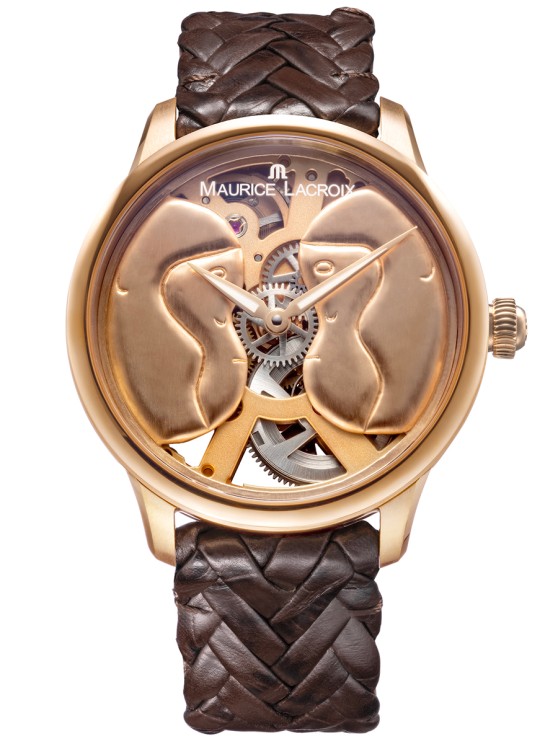
For both Maurice Lacroix and the artist, this journey of discovery is the creative goal; a world where dreams promise discovery. In this instance, the journey has culminated in the creation of a Masterpiece par excellence.
The name of the watch, ‘With what eyes?’ originates from the Greek poet Sapho and shares the same title as the artist’s installation, hosted at the Wattis Institute in San Francisco. For this exhibition, Hernández presented a series of hand-hammered, stainless steel depictions of monkeys. This collection of thought-provoking works echoes the sentiments of Marcel Proust, “The only true voyage would not be to visit strange lands but to possess other eyes, to see the universes that each of them sees.”
